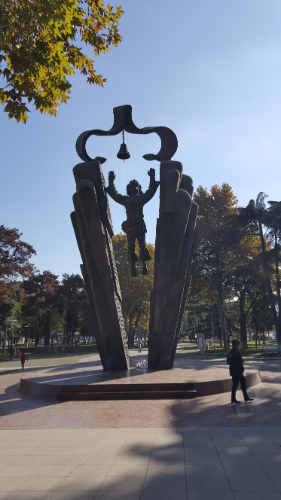
As promised, brace yourself for some history! I’m sure most Armenians would never admit it, but Georgia and Armenia have had somewhat similar historical experiences and are similar culturally. Both countries declared Christianity the state religion in the early 4th century, though any Armenian will quickly tell you that Armenia was first in 301 AD. Georgia followed not long after in 337 AD. Predictably, the populations today are majority Christian, though it would be interesting to know how religiously active people in Georgia are. In Armenia, practically everyone will say that they’re Christian and practically no one regularly attends church. I imagine a lot of that has to do with the 70 secular years of the Soviet Union which would mean that you’d expect Georgia to be in a similar situation. I don’t know if that’s true or not, though.
As usual, I’m getting ahead of myself… I could go into detail about the years between the beginning of the world and modern times, but that could take all day. Let me focus on the highlights.
The oldest wine jars in the world were found in Georgia. This is apparently a commonly ignored fact by the people who insist that Armenians invented wine because the world’s oldest winery was found here. The wine jars are around 2,000 years older, but I’m sure that any good Armenian would quickly recover and maintain their claims by telling you that either 1. wherever those jars were found used to be Armenia, 2. whoever made the wine was definitely Armenian and the Georgians just bought some because it was so good, or 3. the Georgians were jealous, so they fabricated history and the jars are a lie.

Throughout history, both countries spent a considerable amount of time getting conquered and reconquered by different empires and dynasties. They each had their golden ages when they were on top, and those were both short-lived. For a while, the Byzantine Empire and then Ottoman Turkey controlled both western Georgia and Western Armenia. Eastern Armenia and eastern Georgia were under the rule of the Persians and later the Russian Empire. The Russian Empire managed to win back many of the Ottoman-controlled regions of Georgia, reuniting the country. Western Armenia, on the other hand, remained under Ottoman rule. (Side note: this long period of being ruled by different empires is much of the reason for the linguistic and cultural differences between Western Armenians – most of the Diaspora – and Eastern Armenians – most of the people in modern-day Armenia.)
In 1918 at the end of World War I, both Armenia and Georgia set up their first republics and swiftly got into a border conflict with one another. It seems like every single one of these stories has the same plot line. Two countries. One believes that the land should be allocated based on historical claims or majority populations. The other believes that the land should be allocated based on a random line drawn by some random, powerful country. You can probably guess that each chooses its stance based on which is most beneficial to them. They fought for about a month until the British got involved, and the border landed where it is now with part of the disputed territory in each country.

Both countries had short-lived independence as they got sucked into the Soviet Union in 1921. They were combined with Azerbaijan to form the “Transcaucasian Socialist Federative Soviet Republic” until it was re-split into those three parts in 1936. After 70 years as part of the Soviet Union, Armenia and Georgia became independent again in 1991 and formed their second republics.
Now, Georgia is an important trade partner for Armenia because the Armenia-Georgia border is the largest open border that Armenia has left (since the west and east borders with Turkey and Azerbaijan are closed due to the ongoing conflict with Azerbaijan in Karabakh). However, Armenia is allied with Russia and is on bad terms with Turkey and Azerbaijan. Georgia is having its own territory issues because two of its regions have declared independence, supported by Russia, and Georgia refuses to recognize them. So, Georgia and Russia are on bad terms, and Georgia is allied with Turkey and Azerbaijan.
Does your head hurt? My head hurts. You don’t even know how much I left out, but just say thank you. The Armenian/Georgian relationship is fragile at best, but the Armenian government at least isn’t going to do anything to mess it up. It hasn’t recognized either of Georgia’s “independent” regions, but that’s not surprising because it also hasn’t recognized Karabakh/Artsakh as independent even though the Armenian military is physically involved in that conflict. I think Armenia’s international stance is “we really can’t afford to get on anyone else’s bad side so let’s be as diplomatic as we can about everything and not make anyone mad”.

Okay, so there you go! Some mind-numbing historical background. I guess my point was to show that the two countries have kind of been living parallel histories, and it’s interesting to see how they’ve reacted in similar ways to some things and in very different ways to others.
I’ll get into fun sightseeing stuff in the next post. No more long history, I promise! (Short history though… there will likely be some short history.)
